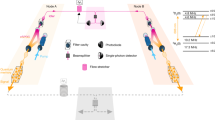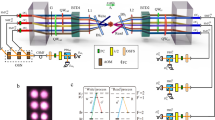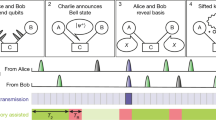Abstract
Owing to the inevitable loss in communication channels, the distance of entanglement distribution is limited to approximately 100 kilometres on the ground1. Quantum repeaters can circumvent this problem by using quantum memory and entanglement swapping2. As the elementary link of a quantum repeater, the heralded distribution of two-party entanglement between two remote nodes has only been realized with built-in-type quantum memories3,4,5,6,7,8,9. These schemes suffer from the trade-off between multiplexing capacity and deterministic properties and hence hinder the development of efficient quantum repeaters. Quantum repeaters based on absorptive quantum memories can overcome such limitations because they separate the quantum memories and the quantum light sources. Here we present an experimental demonstration of heralded entanglement between absorptive quantum memories. We build two nodes separated by 3.5 metres, each containing a polarization-entangled photon-pair source and a solid-state quantum memory with bandwidth up to 1 gigahertz. A joint Bell-state measurement in the middle station heralds the successful distribution of maximally entangled states between the two quantum memories with a fidelity of 80.4 ± 2.2 per cent (±1 standard deviation). The quantum nodes and channels demonstrated here can serve as an elementary link of a quantum repeater. Moreover, the wideband absorptive quantum memories used in the nodes are compatible with deterministic entanglement sources and can simultaneously support multiplexing, which paves the way for the construction of practical solid-state quantum repeaters and high-speed quantum networks.
This is a preview of subscription content, access via your institution
Access options
Access Nature and 54 other Nature Portfolio journals
Get Nature+, our best-value online-access subscription
$29.99 / 30 days
cancel any time
Subscribe to this journal
Receive 51 print issues and online access
$199.00 per year
only $3.90 per issue
Buy this article
- Purchase on Springer Link
- Instant access to full article PDF
Prices may be subject to local taxes which are calculated during checkout





Similar content being viewed by others
Data availability
The data presented in the figures within this paper and other findings of this study are available from the corresponding authors upon reasonable request. Source data are provided with this paper.
Code availability
The custom codes used to produce the results presented in this paper are available from the corresponding authors upon reasonable request.
References
Yin, J. et al. Quantum teleportation and entanglement distribution over 100-kilometre free-space channels. Nature 488, 185–188 (2012).
Briegel, H.-J., Dür, W., Cirac, J. I. & Zoller, P. Quantum repeaters: the role of imperfect local operations in quantum communication. Phys. Rev. Lett. 81, 5932–5935 (1998).
Chou, C.-W. et al. Functional quantum nodes for entanglement distribution over scalable quantum networks. Science 316, 1316–1320 (2007).
Yuan, Z.-S. et al. Experimental demonstration of a BDCZ quantum repeater node. Nature 454, 1098–1101 (2008).
Yu, Y. et al. Entanglement of two quantum memories via fibres over dozens of kilometres. Nature 578, 240–245 (2020).
Moehring, D. L. et al. Entanglement of single-atom quantum bits at a distance. Nature 449, 68–71 (2007).
Hofmann, J. et al. Heralded entanglement between widely separated atoms. Science 337, 72–75 (2012).
Hensen, B. et al. Loophole-free Bell inequality violation using electron spins separated by 1.3 kilometres. Nature 526, 682–686 (2015).
Delteil, A. et al. Generation of heralded entanglement between distant hole spins. Nat. Phys. 12, 218–223 (2016).
Gisin, N. & Thew, R. Quantum communication. Nat. Photon. 1, 165 (2007).
Sangouard, N., Simon, C., de Riedmatten, H. & Gisin, N. Quantum repeaters based on atomic ensembles and linear optics. Rev. Mod. Phys. 83, 33–80 (2011).
Yin, J. et al. Satellite-based entanglement distribution over 1200 kilometers. Science 356, 1140–1144 (2017).
Zhao, B., Chen, Z.-B., Chen, Y.-A., Schmiedmayer, J. & Pan, J.-W. Robust creation of entanglement between remote memory qubits. Phys. Rev. Lett. 98, 240502 (2007).
Sinclair, N. et al. Spectral multiplexing for scalable quantum photonics using an atomic frequency comb quantum memory and feed-forward control. Phys. Rev. Lett. 113, 053603 (2014).
Simon, C. et al. Quantum repeaters with photon pair sources and multimode memories. Phys. Rev. Lett. 98, 190503 (2007).
Gündoğan, M., Ledingham, P. M., Kutluer, K., Mazzera, M. & de Riedmatten, H. Solid state spin-wave quantum memory for time-bin qubits. Phys. Rev. Lett. 114, 230501 (2015).
Zhong, M. et al. Optically addressable nuclear spins in a solid with a six-hour coherence time. Nature 517, 177–180 (2015).
Saglamyurek, E. et al. A multiplexed light–matter interface for fibre-based quantum networks. Nat. Commun. 7, 11202 (2016).
Zhou, Z.-Q., Lin, W.-B., Yang, M., Li, C.-F. & Guo, G.-C. Realization of reliable solid-state quantum memory for photonic polarization qubit. Phys. Rev. Lett. 108, 190505 (2012).
Zhong, T. et al. Nanophotonic rare-earth quantum memory with optically controlled retrieval. Science 357, 1392–1395 (2017).
Tang, J.-S. et al. Storage of multiple single-photon pulses emitted from a quantum dot in a solid-state quantum memory. Nat. Commun. 6, 8652 (2015).
Zhou, Z.-Q. et al. Quantum storage of three-dimensional orbital-angular-momentum entanglement in a crystal. Phys. Rev. Lett. 115, 070502 (2015).
Yang, T.-S. et al. Multiplexed storage and real-time manipulation based on a multiple degree-of-freedom quantum memory. Nat. Commun. 9, 3407 (2018).
Afzelius, M., Simon, C., de Riedmatten, H. & Gisin, N. Multimode quantum memory based on atomic frequency combs. Phys. Rev. A 79, 052329 (2009).
Gühne, O. & Tóth, G. Entanglement detection. Phys. Rep. 474, 1–75 (2009).
Dousse, A. et al. Ultrabright source of entangled photon pairs. Nature 466, 217–220 (2010).
Liu, C. et al. On-demand quantum storage of photonic qubits in an on-chip waveguide. Phys. Rev. Lett. 125, 260504 (2020).
Li, P.-Y. et al. Hyperfine structure and coherent dynamics of rare-earth spins explored with electron–nuclear double resonance at subkelvin temperatures. Phys. Rev. Appl. 13, 024080 (2020).
Sabooni, M., Li, Q., Kröll, S. & Rippe, L. Efficient quantum memory using a weakly absorbing sample. Phys. Rev. Lett. 110, 133604 (2013).
Rančić, M., Hedges, M. P., Ahlefeldt, R. L. & Sellars, M. J. Coherence time of over a second in a telecom-compatible quantum memory storage material. Nat. Phys. 14, 50–54 (2018).
Bao, X.-H. et al. Generation of narrow-band polarization-entangled photon pairs for atomic quantum memories. Phys. Rev. Lett. 101, 190501 (2008).
James, D. F. V., Kwiat, P. G., Munro, W. J. & White, A. G. Measurement of qubits. Phys. Rev. A 64, 052312 (2001).
Browne, D. E. & Rudolph, T. Resource-efficient linear optical quantum computation. Phys. Rev. Lett. 95, 010501 (2005).
Pan, J.-W., Bouwmeester, D., Weinfurter, H. & Zeilinger, A. Experimental entanglement swapping: entangling photons that never interacted. Phys. Rev. Lett. 80, 3891–3894 (1998).
Xu, P. et al. Two-hierarchy entanglement swapping for a linear optical quantum repeater. Phys. Rev. Lett. 119, 170502 (2017).
Huber, D. et al. Strain-tunable GaAs quantum dot: a nearly dephasing-free source of entangled photon pairs on demand. Phys. Rev. Lett. 121, 033902 (2018).
Wang, H. et al. On-demand semiconductor source of entangled photons which simultaneously has high fidelity, efficiency, and indistinguishability. Phys. Rev. Lett. 122, 113602 (2019).
Liu, J. et al. A solid-state source of strongly entangled photon pairs with high brightness and indistinguishability. Nat. Nanotechnol. 14, 586–593 (2019).
Liu, X., Zhou, Z.-Q., Hua, Y.-L., Li, C.-F. & Guo, G.-C. Semihierarchical quantum repeaters based on moderate lifetime quantum memories. Phys. Rev. A 95, 012319 (2017).
Jin, J. et al. Entanglement swapping with quantum-memory-compatible photons. Phys. Rev. A 92, 012329 (2015).
Clauser, J. F., Horne, M. A., Shimony, A. & Holt, R. A. Proposed experiment to test local hidden-variable theories. Phys. Rev. Lett. 23, 880–884 (1969).
Clausen, C. et al. Quantum storage of photonic entanglement in a crystal. Nature 469, 508–511 (2011).
Saglamyurek, E. et al. Broadband waveguide quantum memory for entangled photons. Nature 469, 512–515 (2011).
Jobez, P. et al. Coherent spin control at the quantum level in an ensemble-based optical memory. Phys. Rev. Lett. 114, 230502 (2015).
Ortu, A. et al. Simultaneous coherence enhancement of optical and microwave transitions in solid-state electronic spins. Nat. Mater. 17, 671–675 (2018).
Kindem, J. M. et al. Control and single-shot readout of an ion embedded in a nanophotonic cavity. Nature 580, 201–204 (2020).
Rakonjac, J. V., Chen, Y.-H., Horvath, S. P. & Longdell, J. J. Long spin coherence times in the ground state and in an optically excited state of 167Er3+:Y2SiO5 at zero magnetic field. Phys. Rev. B 101, 184430 (2020).
Businger, M. et al. Optical spin-wave storage in a solid-state hybridized electron–nuclear spin ensemble. Phys. Rev. Lett. 124, 053606 (2020).
Bussières, F. et al. Quantum teleportation from a telecom-wavelength photon to a solid-state quantum memory. Nat. Photon. 8, 775–778 (2014).
Puigibert, M. G. et al. Entanglement and nonlocality between disparate solid-state quantum memories mediated by photons. Phys. Rev. Res. 2, 013039 (2020).
Lvovsky, A. I., Sanders, B. C. & Tittel, W. Optical quantum memory. Nat. Photon. 3, 706–714 (2009).
Hedges, M. P., Longdell, J. J., Li, Y. & Sellars, M. J. Efficient quantum memory for light. Nature 465, 1052–1056 (2010).
Acknowledgements
This work is supported by the National Key R&D Program of China (no. 2017YFA0304100), the National Natural Science Foundation of China (nos 11774331, 11774335, 11504362, 11821404 and 11654002), Anhui Initiative in Quantum Information Technologies (no. AHY020100), the Key Research Program of Frontier Sciences, CAS (no. QYZDY-SSW-SLH003), the Science Foundation of the CAS (no. ZDRW-XH-2019-1), and the Fundamental Research Funds for the Central Universities (nos WK2470000026, WK2470000029 and WK2030000022). Z.-Q.Z. acknowledges the support from the Youth Innovation Promotion Association, CAS.
Author information
Authors and Affiliations
Contributions
Z.-Q.Z. and C.-F.L. designed the experiment. X. Liu and J.H. carried out the experiment with assistance from Z.-F.L. and X. Li. P.-Y.L. and P.-J.L. helped collect the data. X. Liu, J.H. and Z.-Q.Z. analysed the data and wrote the paper with input from all other authors. The project was supervised by Z.-Q.Z., C.-F.L. and G.-C.G. All authors discussed the experimental procedures and results.
Corresponding authors
Ethics declarations
Competing interests
The authors declare no competing interests.
Additional information
Peer review information Nature thanks Daniel Oblak and the other, anonymous, reviewer(s) for their contribution to the peer review of this work.
Publisher’s note Springer Nature remains neutral with regard to jurisdictional claims in published maps and institutional affiliations.
Extended data figures and tables
Extended Data Fig. 1 Experimental setup and characterizations of entangled photon-pair sources.
a, Detailed setup for entangled photon-pair sources. b, c, Power dependence of the coincidence counting rate and second-order-correlation function \({g}_{12}^{(2)}(2\,{\rm{ns}})\) for each entangled photon-pair source located at two nodes, respectively. Error bars in b and c represent one standard deviation. DM, dichroic mirror; IF, interference filter; QM, quantum memory.
Extended Data Fig. 2 Characterization of the heralded entangled photon pairs.
a, The fidelity of heralded entangled photon pairs as a function of average \({g}_{12}^{(2)}(2\,{\rm{ns}})\) of two sources. b, Measured S parameter of CHSH-type Bell’s inequality with respect to the average \({g}_{12}^{(2)}(2\,{\rm{ns}})\). Error bars are one standard deviation.
Extended Data Fig. 3 An example of an AFC structure with a bandwidth of 1 GHz.
The central 200-MHz AFC is generated by an AOM, and the four sidebands are generated by an EO-PM in parallel. The total AFC bandwidth is approximately 1 GHz. The AFC structure is determined by the transmission of weak probe light using single-photon detectors. The polarization of the probe light is chosen as H + V.
Extended Data Fig. 4 The AFC echo intensity as a function of storage time.
The echo intensity (blue point) is normalized to the value of 55.6-ns storage time. Error bars represent one standard deviation. The red line is double exponential fit (Ae−t/τ1 + Be−t/τ2) of the experimental data, with A = 1.04, B = 0.29, τ1 = 134 ns and τ2 = 1,141 ns. The 1/e lifetime of storage efficiency is deduced to be 193 ns based on fitted data. a.u., arbitrary units.
Extended Data Fig. 5 Temporal multiplexed operations of a quantum memory.
a, A schematic diagram of temporally multiplexed operation. Compared to a single-mode scenario, four temporal modes are stored within the 55.6-ns storage time in the experiment. b, The estimated entanglement distribution rate (EDR) as a function of the mode number. The red star is achieved EDR with multiplexing of four time modes achieved in the experiment and the grey dots are estimated values based on experimental data.
Extended Data Fig. 6 Estimated fidelity of heralded remote entanglement between two quantum memories as a function of storage efficiency.
The blue dot is the data measured in the experiment and the black solid line is the simulation based on experimentally determined background noise. The red dashed line represents the fidelity of the classical bound. The error bar of the blue dot is one standard deviation.
Rights and permissions
About this article
Cite this article
Liu, X., Hu, J., Li, ZF. et al. Heralded entanglement distribution between two absorptive quantum memories. Nature 594, 41–45 (2021). https://doi.org/10.1038/s41586-021-03505-3
Received:
Accepted:
Published:
Issue Date:
DOI: https://doi.org/10.1038/s41586-021-03505-3
This article is cited by
-
Quantum storage of 1650 modes of single photons at telecom wavelength
npj Quantum Information (2024)
-
Coherent memory for microwave photons based on long-lived mechanical excitations
npj Quantum Information (2023)
-
Hertz-rate metropolitan quantum teleportation
Light: Science & Applications (2023)
-
Quantum storage of entangled photons at telecom wavelengths in a crystal
Nature Communications (2023)
-
Deterministic Bell state measurement with a single quantum memory
npj Quantum Information (2023)
Comments
By submitting a comment you agree to abide by our Terms and Community Guidelines. If you find something abusive or that does not comply with our terms or guidelines please flag it as inappropriate.



